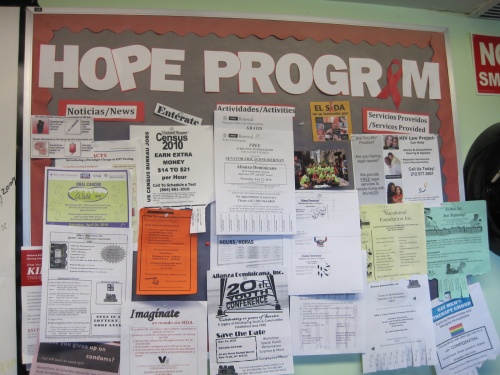From The Integration of Dominican, Chinese, Russian and Mexican Immigrants in NYC
This is the placeholder page for language issues.
Contents |
Dominican Immigrants
A staggering 70% of Dominican immigrants are not proficient in the English language. Numbers are limited when describing a group of people, but a visit to Washington Heights explains it perfectly.
Alianza Dominicana H.O.P.E. (Holistic Orientation and Prevention Education)
 H.O.P.E. aims to educate the public about sexual education. They offer services such as pre-natal care, H.I.V. testing, counseling, and support groups for the lesbian and gay society. All services are provided in both Spanish and English. A representative of H.O.P.E. says that 95% of the population they cater to are Dominican and that their services are in high demand. She herself spoke broken English and when I asked for a brochure, she was only able to provide one in Spanish.
H.O.P.E. aims to educate the public about sexual education. They offer services such as pre-natal care, H.I.V. testing, counseling, and support groups for the lesbian and gay society. All services are provided in both Spanish and English. A representative of H.O.P.E. says that 95% of the population they cater to are Dominican and that their services are in high demand. She herself spoke broken English and when I asked for a brochure, she was only able to provide one in Spanish.
Alianza Dominicana La Familia Unida Day Care Center
La Familia Unida is a day care center open to all children with working mothers. Because the day care center is funded by the government, the child(ren) enrolled must have a Social Security Number, however the mother does not. This means that the services provided are open to both documented and undocumented parents. They simply ask for a 1069 form that the employer must fill out as proof that the parents are working.
Simona Santos, Educational Director at La Familia Uida Day Care Center describes the curriculum the young children follow, “3 days of Spanish and 2 days of English.” Although not all the children in their class are Dominican, La Familia Unida understand the importance of language acquisition, however it seems the emphasis is placed on Spanish, not English.
This main office of Alianza Dominicana offers many services ranging from aid in applying for free healthcare to aid in housing applications. One of the most popular services Alianza Dominicana provides is the translation of forms. A representative I spoke to said that many, many people arrive asking for help filling out forms that are in English. The organization also offers counseling services in Spanish for victims of domestic violence, drug abuse and pre-natal care. All services and aid are provided regardless of documentation status however those who are undocumented are limited in taking advantage of all the services the government can provide such as free health insurance.On a side note, an observation I made was that all the brochures and fliers offered on the table were in Spanish. When asking the representative why this was so, she shrugged and said, “This is what we have. We offer Spanish fliers because the people only speak Spanish. Anything in English is from outside organizations.”
Dominican Women’s Development Center
The Dominican Women’s Development Center offers a large range of services to women and families. Their goal is to help ease the integration experience of immigrants and in essence, help immigrants gain the confidence they need to live happily in a new country. Xiomara Santoz-Abre explains and emphasizes the problems that arise during integration, language acquisition being one of them. Over 85% of the people the organization help are Dominican. All workers and volunteers must speak both Spanish and English in order to communicate with the patrons. DWDC offers ESL classes and aid in the process of attaining citizenship (form translations and test preparation). DWDC also offers free legal advice since many new (and old) immigrants do not understand the legal system, especially those who are not proficient in English.
Xiomara not only highlights the problems that arise when immigrants cannot speak English but the problems that arise when Americans misinterpret body language, facial expressions and actions. The organization aims to not only educate immigrants, but to empower them and teach them the skills necessary to defend themselves as Americans.
Chinese Immigrants
Brooklyn Chinese-American Association on Language by: Jerrica Williams. I interviewed Carol Wu on April 27th, 2010 " Language is most definitely the most difficult challenge for the people we see, " said Wu. " Ninety percent do not speak English. " Fortunately, BCA offers free ESL classes which is the most frequently used service they offer. BCA offers ESL classes seven days a week to over 1800 people. They have very basic classes but also more advanced classes that teach computer programs. Because they are a non-profit organization, many people take advantage. " You see all these people? They are all asking for our help. They need our help " Wu said.
I learned the most from this information. I knew that Chinese Americans had difficulty with language, but it astonished me that 90% of the people they helped could not speak English. From the looks of the pouring numbers they receive in ESL classes, it seems as if the Chinese community actually wants to change this.
Adult Learner Program at the Flushing Queens Library
Interview with: Gary Beharry-- Library Literacy Center Assistant Manager
What They Provide:
The Adult Learner Program works with adult immigrants between the ages of 40-60. The services they provide help the immigrants integrate into American society. They have workshops on applying for citizenship, health literacy, and basic day to day activities. What they focus most on is language. According to Mr. Beharry " Language bridges everything together " The services that they do help the immigrants obtain survival skills in New York, but what that really comes down to is being able to communicate in the most basic situation. The immigrants learn how to communicate while grocery shopping, transportation, doctor visits and more. The Adult Learner Program takes the immigrants on field trips throughout the city, where they can practice their language skills.
Problems They Face:
According to Mr. Beharry, the biggest struggle is not having enough programs like theirs to help the immigrants. The Adult Learner Program is funded by the city and state government, but they cannot accommodate everyone. Over the course of 3 days they can get 500 applications. They then use a lottery to select 10-20 participants a day. This means they barely take a third of the immigrants applying. More programs to help learn English would benefit the people and make it easier to integrate.
Interview conducted on April 28, 2010
Mexican Immigrants
Russian Immigrants
An Interview with an ImmigrantBy Michelle Ranello
When Alice Gilman came to America in 1988 she did not know any English. She only new letters and when she came here making it very difficult at first. Her fathers brother came here in the 70s suggested that she should go to school to learn English. She had already graduated school in Russia. So she took an ESL class and didn't learn much. All of her friends in that class were Russian so they didn't need to know English to speak to one another. Alice started working part time after school in the clothing store Rainbow and that is were she started using English.
St Michael's Chapel
As previously stated in the education section of the wiki, the Church provides language classes for both the English and Russian language. Since their organization does mostly tend to attract Russian members, both classes are Russian dominant. However, in the English classes, they do have a few participants that are not of Russian background.
They fully support the process of linguistic integration although they do also recommend to preserve their Russian language in New York City. Reverend Deacon does believe that language is one of the more difficult obstacles of full integration into American society.
The Church, unfortunately, does not have as many participating members taking part in their non-religious organizations. They use their religious community as a source of support and comfort not just as a place to pray. "That's what we try and do, help each other out when we need it the most regardless of our background if were white, brown, red, or if we follow the religion of Buddhism or even the lyrics of Isaac Hayes, we're all human."
Brighton Beach Neighborhood Association- Pat Singer
by Jensen Rong and Kevin Lee
We interviewed a woman named Pat Singer who is the head of the Brighton Beach Neighborhood Association, an organization that has a sizeable and yet slowly growing influence in the Brighton Beach community.
Brighton Beach is “the” textbook definition of an enclave community. If you were to go down the streets by the Boardwalk you would see signs completely in Russian. There are individuals who have lived their entire lives in this community without even learning a word of English.
Despite the overwhelming presence of Russian Immigrants, Brighton Beach still is home to a minority population of Pakistanis and Hispanics that is woefully underrepresented by the mostly Russian-born community leaders. Ms. Singer has networked with a motley mix of other organizations to get a wider cultural representation for Brighton Beach.
The language obstacle is one problem that the BBNA tries to address is the ethnocentrism of Brighton Beach. The organization has lobbied for different causes, such as the passing of a law that requires the signs to have English on them. This way, tourists and non-Russian inhabitants won’t be discouraged from shopping in their districts. (Vid2 11:00)
The political processes in Brighton Beach are inhibited by the ethnocentricity. Entire town meetings would be held in Russian, and attended by a virtually 100% Russian audience. The dominance of the Russian population in Brighton Beach politics ensures the perpetuation of the enclave community and the nonparticipation of the other immigrant groups.
Shorefront YM-YWHA of Brighton
An interview with Lawrence Fish, Director of Adult Educational, Vocational and Citizenship Services
The organization offers more than 100 classes a year at convenient times and locations. They taught in the morning, afternoon or evening in six locations throughout South Brooklyn.
Their classes are free and meet two to three times a week. They hire bilingual specialists and teach to students from over 50 different countries.
With that said, Lawrence states that they do primarily serve Russian immigrants because of the high volume of Russian speakers in the community. He also says that the wishes more people would attend the classes, but he understands that most of the population of Brighton believes it is not completely necessary to learn English. This is because the over 90% of the neighborhood's population speaks Russian, and it is apparent to anyone that takes a walk around the area.






